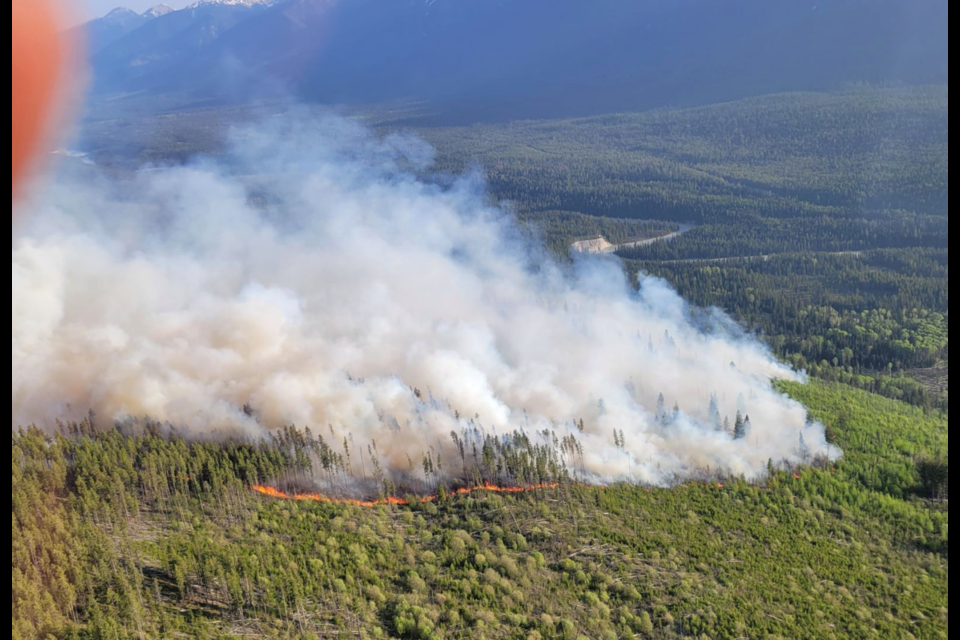KOOTENAY NATIONAL PARK – Parks Canada firefighters are continuing to battle a lightning-sparked blaze in tough conditions in Kootenay National Park, B.C., where the fire has now burned 75 hectares and is still growing.
Charlie McLellan, incident commander and fire and vegetation specialist for Lake Louise, Yoho and Kootenay, said the Mitchell Ridge fire was sparked by lightning on Wednesday evening (May 17) and is classified as out of control.
He said there are five initial attack crews and three helicopters working to contain the fire, which is located in the Mitchell Ridge area of southern Kootenay National Park, approximately two kilometres east of the Kootenay Valley viewpoint and seven kms north of Nipika Mountain Resort.
“For this time of year, it's extremely challenging. We’re seeing temperatures and fuel indices and dryness that we normally experience more into mid-July and into August,” he said.
“We had a late fall and reduced snowpack through the winter and we've come into the season with a bit of overwinter drought, so it has been challenging for this time of year.”
But McLellan said the good news is there is rain and cooler temperatures in the forecast for Sunday evening, May 21, and into Monday, May 22.
“Starting Monday, we'll be back to more seasonal or even below seasonal conditions and it looks like we'll get a pretty good dose of precipitation,” he said.
“That's really going to allow us to get good containment on this fire.”
Alberta wildfire data from 2006-23. Data from Alberta Wildfire as of May 20 and chart by Greg Colgan, RMO.
Warm temperatures and windy conditions have continued to fuel the flames since Thursday morning, but fire officials say there is still no immediate threat to public safety or infrastructure.
“On the first day it had grown upslope as you'd expect, and given the conditions, it was unsafe to really be above the fire to manage it,” said McLellan, noting it grew to 15 hectares by the end of day Thursday, 21 hectares by Friday and 40 hectares on Saturday morning.
The blaze has reached the eastern boundary of Kootenay National Park where the rate of growth has slowed due to a change in aspect and fuel types.
But McLellan said he expects the fire will grow beyond the current 75 hectares on Saturday afternoon and Sunday.
“We expect a bit of growth, but what’s been fortunate is as it hits the top of the ridge along the provincial boundary, there's an aspect change so it goes from west-facing more to east, and then there’s also a fuel change and that's been really helpful in reducing the spread at that location,” he said
“We might, depending on the wind direction, get a bit of spread to the north into the park, but that's certainly the direction that’s favourable for this fire."
Parks Canada says the fire is still seven kilometres from Nipika Mountain Resort.
“That would be the closest facility and, with the direction of movement, it hasn't got any closer,” said McLellan.
In neighbouring Alberta where there is a provincial state of emergency, intense wildfires continue to burn. As of Saturday afternoon, there were 87 active wildfires and more than 10,000 people still out of their homes.
McLellan said firefighters are hoping that rainfall in June – known locally as June Monsoon – will help firefighters in Alberta and B.C.
“Normally June is our wettest month in the mountain national parks, although it is hard to know at this point what June will look like,” he said.
“But maybe it can help reduce anxiety levels for people around fire as we enter summer because typically we get lots of precipitation in late-May and into June.”
Lightning also sparked a second fire in Kootenay National Park on Wednesday, located on the slopes of Mount Crook in an area of the park known as Lightning Alley.
McLellan said Parks Canada was quick to extinguish that fire, which never grew beyond 0.1 hectares.
“It was higher on the slopes on the kind of north or east-facing slopes and higher in elevation, so it didn’t cause us many problems,” he said. “That spot fire was extinguished.”
While these two wildfires were sparked by lightning, Parks Canada stresses the importance of preventing human-caused fires.
“We ask that people be more vigilant than they normally would be on a May long weekend and this time of year so we can focus any efforts to lightning-caused fires and not so much human-caused ones,” McLellan said.
Alberta wildfire data from 2006-23. Data from Alberta Wildfire as of May 20 and chart by Greg Colgan, RMO.




